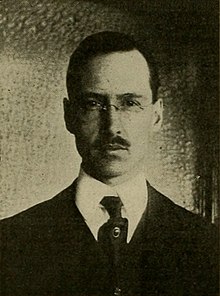
Summary
John Randolph Bray (August 25, 1879 – October 10, 1978) was an American animator, cartoonist, and film producer.
John Randolph Bray | |
|---|---|
 Bray in 1915 | |
| Born | August 25, 1879 |
| Died | October 10, 1978 (aged 99) Bridgeport, Connecticut, U.S. |
| Occupation | Animator |
| Spouse |
Margaret Till
(m. 1904; died 1967) |
Early life edit
John Randolph Bray was born in Addison, Michigan on August 25, 1879,[2] to Methodist Presbyterian minister Edward Bray and his wife Sarah. He was educated at the Detroit School of Boys and the Detroit School of Art. Bray enrolled at the Michigan's Alma College for a degree in civil engineering, but dropped out after a year.[3]
Work edit
After he dropped out of college, Bray was a journalist for the Detroit Evening Press, however this proved fruitless. A couple years after this job, Bray landed a job for the Brooklyn Daily Eagle, in which he met his friend Max Fleischer. While he was in Brooklyn, he met an immigrant from Germany named Margaret Till, and they married in 1904. He worked for Judge from 1907 to 1909, drawing a comic named Little Johnny and the Teddy Bears, simply named The Teddy Bears in its first run.[3][4]
Bray became interested in animation in the early years of moving pictures. In 1913, his first animated film was released, titled The Artist's Dream.[5] By 1914, he opened a New York area studio specifically organized to make animated films.[6] Unlike newspaper cartoonist Winsor McCay, who had been making short animated films for several years, Bray organized his studio according to the principles of industrial production, an approach that Raoul Barré, another animator, also adopted at around the same time.[7]
As the 1910s progressed, Bray's studio became a powerhouse in the early animation industry. The studio assembled a staff that included many accomplished animators, and it produced a steady and widely distributed stream of animated shorts.[8] Bray contributed a series featuring his Colonel Heeza Liar series, which was among the most popular series of animated shorts in that era.[9]
Bray Productions produced over 500 films between 1913 and 1937, mostly animation films and documentary shorts. Cartoonist Paul Terry worked briefly for Bray Studios in 1916. Bray produced the first animated film in color, The Debut of Thomas Cat (1920), in Brewster Color.[10][11]
The entertainment branch of Bray Pictures Corporation closed in 1928. Documentary production for theatrical release continued through the late 1930s. The educational and commercial branch, Brayco, made mostly filmstrips from the 1920s until it closed in 1963. Bray Studios was still in operation in the 1990s due to his grandson Paul.[12][1]
Jam Handy's company, the Jam Handy Organization, began as a Chicago-Detroit division of Bray Studios, to service the auto industry's need for industrial films. Jam Handy made several thousand industrial and sponsored films and tens of thousands of filmstrips, many for the auto industry, closed in 1973.
Bray visited Winsor McCay during his production of Gertie the Dinosaur and claimed to be a journalist writing an article about animation. McCay was very open about the techniques that he developed and showed all the details to Bray. John Randolph Bray later patented many of McCay's methods and unsuccessfully tried to sue the other animator; McCay prevailed, however, and received royalties from Bray for several years thereafter.[13]
Later life edit
Bray celebrated his 96th birthday at the Museum of Modern Art, where they were showing his films from August 25 to August 31, and cut his own birthday cake. He shook hands with everyone and smiled. After this, he said at the reception of the showings, "I don't know what to say because it's been so many years since I've had to do with film. You'll have to excuse me a little bit, because my memory is pretty well gone."[12][14]
J.R. Bray died at his home in Bridgeport, Connecticut on October 10, 1978, at the age of 99.[15]
References edit
- ^ a b "New York Animation: A Tour of Bray Studios – Part 2 |".
- ^ Grant, John (2001). Masters of Animation. Batsford Books. p. 48. ISBN 9780713486285. Retrieved May 16, 2022 – via Google Books.
- ^ a b New York Animation: A Tour of Bray Studios – Part 1
- ^ Bray, John (February 9, 1907). "THE TEDDY BEARS LITTLE JOHNNY BRINGS THEM TO LIFE WITH A WONDERFUL MIXTURE INVENTED BY HIS PA". Judge Magazine. Vol. 52. p. 9.
- ^ Lund, Karen (June 1999). "Innovative Animators". Information Bulletin. Library of Congress. Retrieved May 16, 2022.
- ^ Clarke, James (2007). Animated Films. Virgin Books. pp. 13. ISBN 978-0753512586.
- ^ Wells, Paul (2002). Animation: Genre and Authorship. Wallflower Press. p. 115.
- ^ Arnold, G. B. (2016). Animation and the American Imagination: A Brief History. Praeger. pp. 23–27. ISBN 978-1440833595.
- ^ Barrier, Michael (1999). Hollywood Cartoons: American Animation in Its Golden Age. Oxford University Press. p. 11. ISBN 9780198020790.
- ^ Kroon, Richard W. (2010). A/V A to Z: An Encyclopedic Dictionary of Media, Entertainment, and Other Audiovisual Terms. McFarland. p. 46. ISBN 9780786444052.
- ^ Robertson, Patrick (November 11, 2011). Robertson's Book of Firsts: Who Did What for the First Time. Bloomsbury Publishing. p. 326. ISBN 9781608197385. Retrieved May 29, 2015.
- ^ a b "Great Grandaddy of All Cartoonists Accepts Admirers' Honors at 96". Courier Express. The New York Times. September 8, 1975. Retrieved May 23, 2022.
- ^ Crafton, Donald (1993). Before Mickey: The Animated Film 1898-1928. University of Chicago Press. p. 376. ISBN 9780226116679.
- ^ JOHN RANDOLPH BRAY
- ^ "John R. Bray, 99, film pioneer". The Philadelphia Inquirer. Bridgeport, Connecticut. Associated Press. October 12, 1978. p. 42. Retrieved May 16, 2022 – via Newspapers.com.
External links edit
- John Randolph Bray at IMDb


